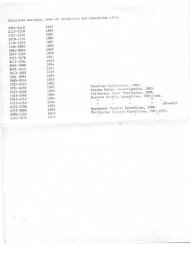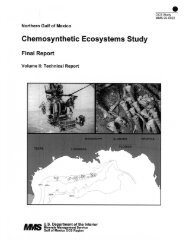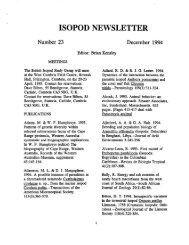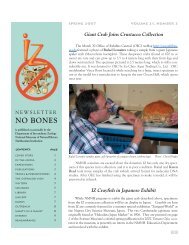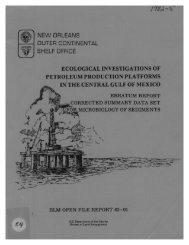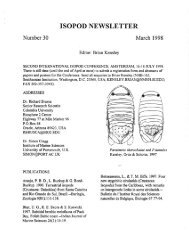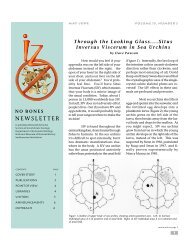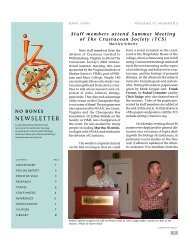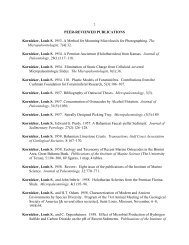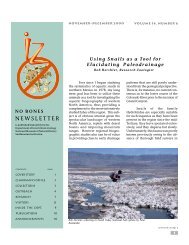Executive Summary - Department of Invertebrate Zoology
Executive Summary - Department of Invertebrate Zoology
Executive Summary - Department of Invertebrate Zoology
Create successful ePaper yourself
Turn your PDF publications into a flip-book with our unique Google optimized e-Paper software.
~<br />
between areas D and E, and J1 on the continental slope <strong>of</strong>f Area F .<br />
These statior ,s constituted a section roughly perpendicular to the<br />
shoreline and slope break and extending from 9 km (15 m depth) to 145<br />
km (400 n depth) <strong>of</strong>fshore (Figure 2) .<br />
1916-1971 Sampiing Yrdr<br />
Second year study objectives remaine .i unchanged and thus, except<br />
fur a few minor changes and the initiation <strong>of</strong> come new studies, the<br />
samF•l+ng scheme for the 1976-1977 sampling year was similar to the<br />
first year .<br />
Benthic Cluster Stations . Preliminary first year results<br />
suggested that some stations could be eliminated due to faunal<br />
similarity with other locations . Thus sampling was discontinued at<br />
the tour cluster stations, C1, C3, D2, and D3 (Figure 2) . These<br />
stations are a considerable distance Inshore from the lease areas and<br />
were yielding little additional information . It was decided to retain<br />
only one ridge and one swale station in each <strong>of</strong> these two cluster<br />
areas .<br />
Benthic Transect Stations . Sairpling at seven transect stations,<br />
Li, L3, Ki, K3, G1, G3, and G7, (rigure 2) was discontinued after the<br />
first sampling year . Stations L1, KI, and G1 were located far from<br />
the lease areas and any pollution event associated with oil<br />
development . Thus it vaa only necessary to document general community<br />
structure over a one year period . Stations L3, K3, and G3, although<br />
some distance seaward <strong>of</strong> L2, K2 . and G2, were only about 10 m greater<br />
in depth than the latter stations and thus faunistically similar .<br />
Sampling at Station G7 was disconr :nu-d because it was faunistically<br />
similar to H1 and H2 and was pe :iph ::rally out <strong>of</strong> the study area .<br />
Wate r Column Stations . .n ;rder to more completely define<br />
seasonal neuston and subsurface zooalankt-n community structure in the<br />
present and future lease area,, ,: trinsect <strong>of</strong> 4 stations (,L1, L2, L4,<br />
L6) from the coast <strong>of</strong> Virginia o the shelf-edge near Norfolk Canyon<br />
was added, as well as two statio .is (B5, A2) to the north <strong>of</strong> the<br />
original transect .<br />
Habitat Delineation StudY . In order to determine if it was<br />
possible to extrapolate results from fixed stations located in<br />
topographically complex areas to other regions <strong>of</strong> the same features,<br />
or to similar features in other areas, and to document the<br />
relationsi(ip between bEnt.hic invertebrates and demersal fishes, a<br />
habitat del+neation study was conducted . Cluster areas B and E were<br />
chosen because many <strong>of</strong> the prime lease tracts are in these reg :ons .<br />
Both regions were stratified bac,ed on existing bathymetry and sediment<br />
data and stations were determin•ad by random select'on <strong>of</strong> Loran C<br />
coordinates . Sampling was conducted during fall 19 76 for oegabenthos<br />
16



